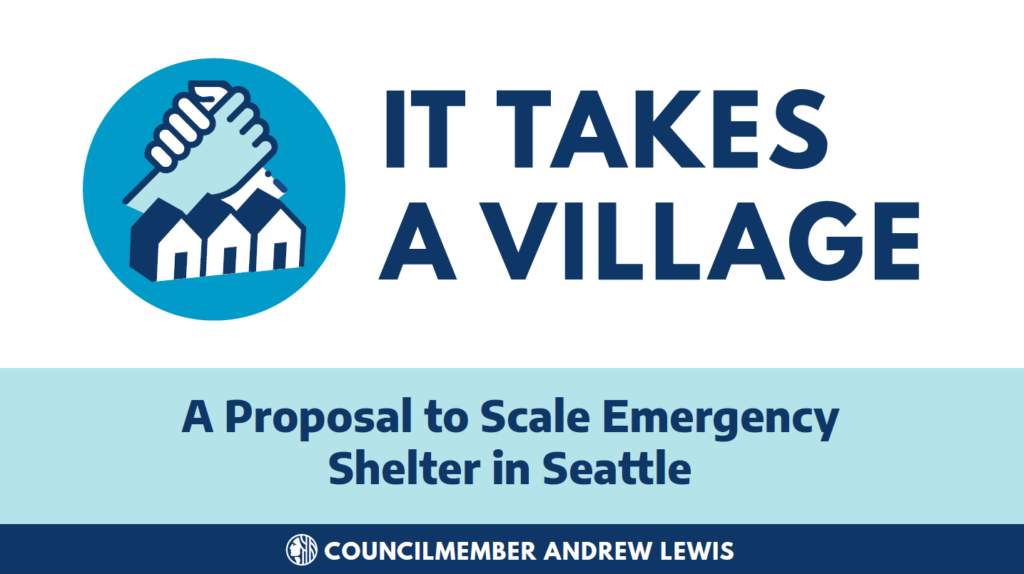‘It Takes A Village’ Approach Will Better Address the Needs of Nearly 4K People Experiencing Unsheltered Homelessness

Councilmember Andrew J. Lewis (District 7 – Pioneer Square to Magnolia) announced his proposal for allowing Seattle to quickly and affordably create more housing options for our homeless neighbors.
Lewis’ launch of “It Takes A Village: A Proposal to Scale Emergency Shelter in Seattle” is intended to better address the needs of nearly 4,000 people (Seattle/King County Point-In-Time Count) experiencing unsheltered homelessness in Seattle. It would scale a proven solution for alleviating unsheltered homelessness: tiny house villages (THV) and, in so doing create at least 480 additional spaces in partnership with help from private sector investments.
To scale the City’s existing THV system, Lewis’ proposal would create a total of 800 tiny houses in 20 villages (an increase from the current offering of 294 tiny houses in eight villages) in an effort to immediately remove tent encampments and instead offer people highly desirable places to stay while they seek permanent housing.
With a startup cost of between $400-600K in capital costs, a number of individuals and large scale businesses are stepping forward to help mitigate costs for annual operations ($800K, 480 additional tiny homes).
Lewis and his Council colleagues will discuss the proposal more formally during a meeting of the Select Committee on Homelessness Strategies & Investments that begins 2:00 p.m. on Wednesday, January 27.
“Tiny houses are not permanent housing. They are emergency shelters combining private individual small houses with communal hygiene and dining facilities. Tiny houses in and of themselves do not end homelessness. Only permanent housing can do that,” said Lewis. “However, tiny house placements can immediately remove tent encampments by providing people highly desirable places to stay while they seek permanent housing.”
“As outreach providers, we are excited about the opportunity to partner with businesses and communities,” said Chloe Gale, the Executive Director of REACH. “Tiny Houses are a good fit for many of the people we encounter who are living outside.”
The plan has two phases and will match existing City resources already appropriated with matching private funds to quickly establish 6 new villages of 40 tiny houses each. Appropriate additional City resources with matching private funds to establish 6 additional villages of 40 tiny houses each by the end of 2021.
“Based on current turnover, we estimate 480 tiny houses would serve 720 people over an 18-month period,” said Sharon Lee, Low Income Housing Institute (LIHI). “That would double the amount of added capacity and bring the shelter spaces gap down to 1,873.”
Councilmember Lewis’ office has identified sites throughout Seattle that are suitable for tiny house villages. Final site assessments are needed to confirm total cost, but assuming the 6 chosen sites cost as much as the most expensive village to date we will need $3.6 million in private one-time donations for the first phase of the initiative.
“As a company active in major metropolitan cities like Chicago, Los Angeles and Vancouver, we know the challenges cities face from accelerating homelessness,” said Duncan Wlodarczak, Onni. “With cities and governments searching for solutions to address this critical issue, Councilmember Lewis’ “It Takes A Village” plan emerges as one of the most innovative, well-constructed, and thoughtfully vetted proposals in any city we have seen. The Onni Group is proud to be an initial supporter of this program and looks forward to working with Councilmember Lew and the ‘It Takes A Village’ team to bring real results to Seattle.”
With $3.6 million in private support, the City can use the entire $4.2 million appropriated for new villages in 2021 for operations.
According to data provided by the Low Income Housing Institute:
- In 2019, 41% of Tiny House villagers exited to stable or transitional housing versus only <1% of overnight shelter residents and 31% of people in enhanced shelter.
- Over the past 5 years 2,800 people have transitioned through the 335 houses. That is an average of 8.3 people per-house.
“If you are a landowner with vacant property of at least 10,000 square feet we need your help. Note that there are property tax exemptions for hosting villages,” added Lewis. “If you are a board member or officer of a charitable foundation, corporate board, or civic organization help us secure a contribution to get this plan going. We are happy to schedule a presentation for your organization. Please call, write-in, or contact my office about volunteer opportunities.”

